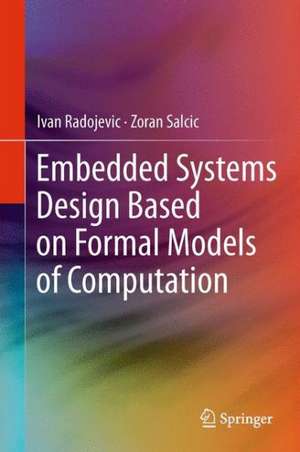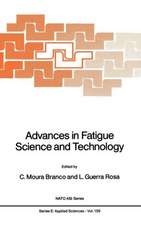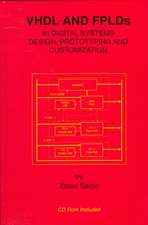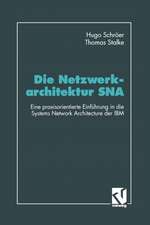Embedded Systems Design Based on Formal Models of Computation
Autor Ivan Radojevic, Zoran Salcicen Limba Engleză Paperback – 16 oct 2014
| Toate formatele și edițiile | Preț | Express |
|---|---|---|
| Paperback (1) | 630.06 lei 6-8 săpt. | |
| SPRINGER NETHERLANDS – 16 oct 2014 | 630.06 lei 6-8 săpt. | |
| Hardback (1) | 640.88 lei 6-8 săpt. | |
| SPRINGER NETHERLANDS – 17 iun 2011 | 640.88 lei 6-8 săpt. |
Preț: 630.06 lei
Preț vechi: 741.25 lei
-15% Nou
Puncte Express: 945
Preț estimativ în valută:
120.58€ • 125.42$ • 99.54£
120.58€ • 125.42$ • 99.54£
Carte tipărită la comandă
Livrare economică 12-26 aprilie
Preluare comenzi: 021 569.72.76
Specificații
ISBN-13: 9789401784153
ISBN-10: 9401784159
Pagini: 200
Ilustrații: XV, 183 p.
Dimensiuni: 155 x 235 x 11 mm
Greutate: 0.29 kg
Ediția:2011
Editura: SPRINGER NETHERLANDS
Colecția Springer
Locul publicării:Dordrecht, Netherlands
ISBN-10: 9401784159
Pagini: 200
Ilustrații: XV, 183 p.
Dimensiuni: 155 x 235 x 11 mm
Greutate: 0.29 kg
Ediția:2011
Editura: SPRINGER NETHERLANDS
Colecția Springer
Locul publicării:Dordrecht, Netherlands
Public țintă
ResearchCuprins
1. Introduction.- 2. Models of Computation and Languages.- 3. Specification in DFCharts.- 4. Semantics of DFCharts.- 5. DFCharts in SystemC and Esterel.- 6. Java Environment for DFCharts.- 7. Heterogeneous Reactive Architectures of Embedded Systems.- 8. Implementation of DFCharts on HiDRA.- 9. Conclusions.- 10. References.
Recenzii
From the reviews:
“The book under review provides a wide overview of issues related to the design of embedded systems, i.e., units usually embedded inside a larger system. … The aspects addressed in this book are up-to-date due to their recent utilization in many areas including, e.g., communications, electronics, or biomedicine. … This book is undoubtedly dedicated to practitioners willing to include formal models of computation into the process of embedded systems design -- the issue being especially important in large scale or critical systems.” (Jozef Woźniak, Zentralblatt MATH, Vol. 1236, 2012)
“The book under review provides a wide overview of issues related to the design of embedded systems, i.e., units usually embedded inside a larger system. … The aspects addressed in this book are up-to-date due to their recent utilization in many areas including, e.g., communications, electronics, or biomedicine. … This book is undoubtedly dedicated to practitioners willing to include formal models of computation into the process of embedded systems design -- the issue being especially important in large scale or critical systems.” (Jozef Woźniak, Zentralblatt MATH, Vol. 1236, 2012)
Textul de pe ultima copertă
One of the key problems in modern embedded systems design is the productivity gap. While the performance of computing architectures has been rapidly increasing in the past few decades, design tools have not kept pace. As a result, it is becoming increasingly difficult for embedded systems designers to handle complex applications. An obvious solution is to raise the abstraction level of design tools and at the same time enable automatic synthesis from high level specifications. This leads to a demand for a formal model of computation, which sets the rules for communication among concurrent processes comprising the system.
Since there is a lack of suitable models of computation for heterogeneous embedded systems containing both control-driven and data-driven behaviors, this book attempts to fill that gap with a new design methodology. At the heart of the methodology lies a model called DFCharts. A complete design flow is covered, from a system specification in a formal language to an implementation on a multiprocessor architecture. The methodology is demonstrated with a practical heterogeneous embedded system applied in power systems monitoring. In addition, suggestions are provided as to how DFCharts-based modeling can be used to improve design with two popular system level languages, SystemC and Esterel. Throughout the book, examples are provided to illustrate main concepts. The reader is not required to have a deep understanding of models of computation. Only basic familiarity is assumed.
Since there is a lack of suitable models of computation for heterogeneous embedded systems containing both control-driven and data-driven behaviors, this book attempts to fill that gap with a new design methodology. At the heart of the methodology lies a model called DFCharts. A complete design flow is covered, from a system specification in a formal language to an implementation on a multiprocessor architecture. The methodology is demonstrated with a practical heterogeneous embedded system applied in power systems monitoring. In addition, suggestions are provided as to how DFCharts-based modeling can be used to improve design with two popular system level languages, SystemC and Esterel. Throughout the book, examples are provided to illustrate main concepts. The reader is not required to have a deep understanding of models of computation. Only basic familiarity is assumed.
Caracteristici
Presents a complete design flow from specification to synthesis on multiprocessor architectures Presents a model of computation which handles heterogeneous embedded systems consisting of both control-driven and data-driven parts Demonstrates how modelling techniques presented can be used to improve design with SystemC and Esterel Includes supplementary material: sn.pub/extras















